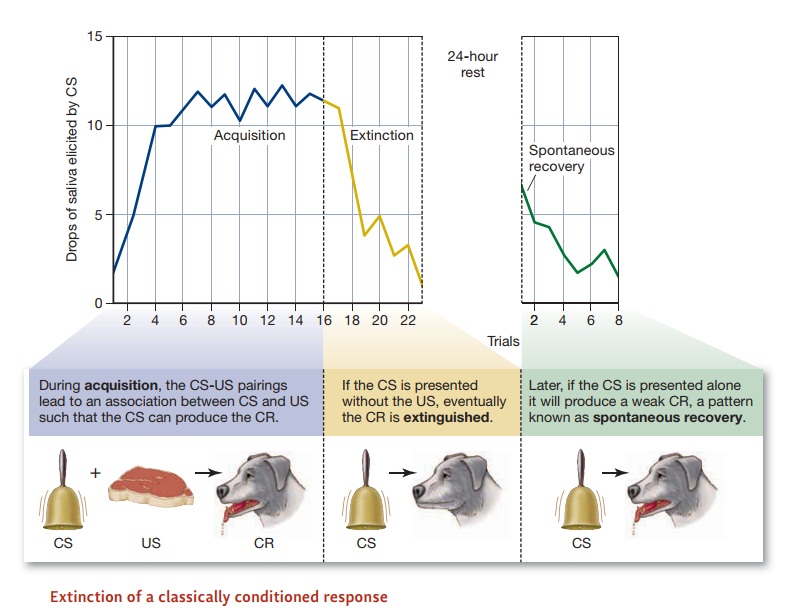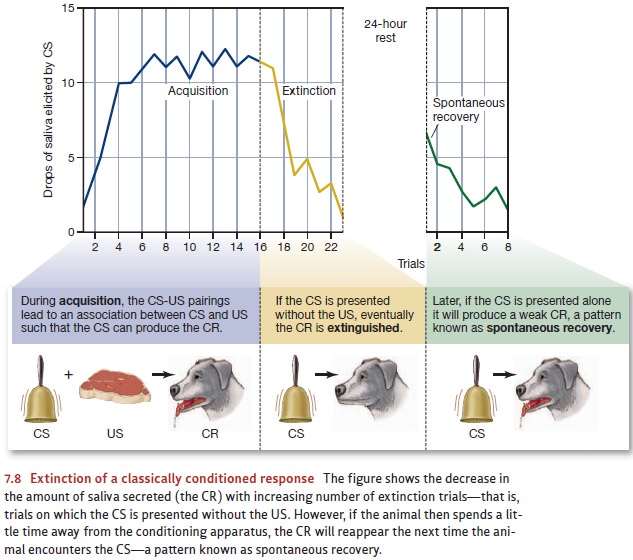Chapter: Psychology: Learning
Classical Conditioning: Extinction

EXTINCTION
Classical conditioning can have
considerable adaptive value. Imagine a mouse that has several times seen the
cat resting on a kitchen chair. It would serve the mouse well to learn about
this asso-ciation between the cat and a particular location; that way, the
mouse will likely feel afraid whenever it nears the kitchen. This fear, in
turn, will probably lead the mouse to avoid that room—a habit that could save
the mouse’s life!
At the same time, it would be
unfortunate for the mouse if this association, once established, could never be
undone. The cat might lose interest in that resting place or leave the
household altogether. Either way, it would be useful for the mouse to lose its
fearful response to the kitchen so it can return there to forage for food.
All is well for this mouse,
though, because the effects of classical conditioning can be undone through a
sequence of events similar to those that established the conditioning in the
first place. Pavlov demonstrated that the CR will gradually disappear if the CS
is pre-sented several times by itself—that is, without the US. For example,
repeated pairings of light plus a blast of cold air will create a condi-tioned
response, so that the animal will shiver (the CR) whenever the light (the CS)
is presented. But if the light is then presented sev-eral times on its own, the
shivering response will be extinguished.Extinction is the undoing of a
previously learned response so that the response is no longer produced (Figure
7.8).

Let’s be clear, though, that
extinction is not just the result of an animal forgetting what it learned
earlier. Of course, animals (including humans) do eventually forget things they
once learned, but that is not what’s going on in extinction. This point is
evident, for exam-ple, in the speed of extinction. As Figure 7.8 shows, a
response can be extinguished in just a half-dozen trials over a period of only
a few minutes. In contrast, forgetting is far slower: To demonstrate this, we
can condition an animal, then leave it alone for several weeks, and then test
it by presenting the CS. In this cicumstance, we have arranged for no
extinction trials, but we have provided an opportunity for forgetting. The
result of this procedure is clear: Even after a substantial delay, the animal
is likely to exhibit a full-blown conditioned response (B. Schwartz, Wasserman,
& Robbins, 2005). It seems, then, that classically con-ditioned responses
are forgotten only very slowly.
The difference between extinction and forgetting is also clear in another procedure. First we condition an animal by repeated pairings of CS and US; then we extinguish the learning by presenting the CS on its own. In a third step, we recondition the same animal—by presenting some more learning trials, just like those in the first step of the procedure. What happens? The reconditioning usually takes much less time than the initial conditioning did. The speed of relearning, in other words, is faster than the orig-inal rate of learning. Apparently, then, extinction doesn’t “erase” the original learning and return the animal to its original naive state. Instead, the animal still has some memory of the learning, and this gives it a head start in the reconditioning trials.
We can draw similar conclusions
about extinction from the phenomenon of spontaneous
recovery. This phenomenon is observed in animals that have beenthrough an
extinction procedure and then left alone for a rest interval. After this rest
period, the CS is again presented, and now the CS often elicits the CR—even
though the CR was fully extinguished earlier (see Figure 7.8).
According to one view of this
effect, the extinction trials lead the animal to recognize that a once
informative stimulus is no longer informative. The bell initially signaled that
food would be coming soon; but now, the animal learns, the bell signals
nothing. However, the animal still remembers that the bell was once
informative; so when a new experimental session begins, the animal checks to
see whether the bell will again be informative in this new setting. Thus, the
animal resumes responding to the bell, pro-ducing the result we call
spontaneous recovery (Robbins, 1990).
Like all aspects of conditioning,
spontaneous recovery can easily be observed out-side of the laboratory and in
humans. For example, various anxiety disorders are often treated via exposure therapy—a process modeled after
the extinction procedure. In this process, the person is repeatedly exposed to
the specific stimulus or the particular situ-ation that has, for that person,
been a source of anxiety—heights, say, or enclosed spaces, or the sight of a
snake. During these exposures, the person is kept safe and comfortable—and so
there’s no fearful US associated with the CS. As we’d expect, this sequence of
events leads to extinction of the CR (the feelings of anxiety)—and with each
exposure, the person feels less and less anxious.
When exposure therapy ends, however,
people often relapse and again become anxious when exposed to the phobic
stimulus. This relapse is not a sign that the therapy has failed. It’s simply
an example of spontaneous recovery of a CR—a sign that more treatment is needed
to eliminate the anxiety.
Related Topics